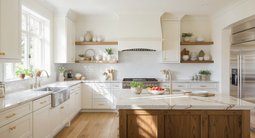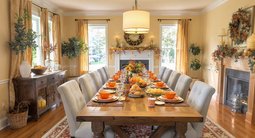TL;DR
A timeless kitchen prioritizes durable, natural materials, a functional layout, and a neutral color scheme that fits your home’s architecture. To design a timeless kitchen that will age well, keep big-ticket elements classic and changeable details flexible. Choose quality cabinetry, simple stone or wood counters, and balanced proportions, then layer personality with lighting, stools, textiles, and art.
Why “timeless kitchen design” matters

A design concept board illustrating quality materials and simple profiles for a kitchen that ages gracefully.
Design a kitchen once, enjoy it for decades. That is the promise behind the idea of a timeless kitchen design.
Here is the thing: no kitchen is truly beyond time. Appliances evolve, finishes cycle, trends swing. The goal is not to be trend-proof; it is to create a room that wears beautifully and is simple to refresh. Think honest materials, simple cabinet profiles, and a layout that works as well for weeknight pasta as it does for a late-night bake. If you are wondering whether a white kitchen is timeless or how to design a timeless kitchen without wasting your budget, the answer lives in quality, proportion, and restraint.
Designers often note that the most enduring spaces echo the architecture of the house. A 1920s bungalow sings with inset Shaker cabinets and soapstone. A mid-century home might favor flat-panel doors and rift oak. The common thread is coherence and craft, not a single color palette or a one-size-fits-all look.
How to design a timeless kitchen
A timeless kitchen favors quality materials, balanced proportions, and a functional layout that follows proven guidelines like 42 to 48 inch work aisles and a clear sink-range-fridge workflow.
- Start with the layout. Experts recommend a work aisle of 42 inches for one cook and 48 inches for two, with island clearances to match. Keep 15 inches of landing space on the pull side of the fridge and at least 24 inches on one side of the sink. The classic work triangle still works, but in larger rooms a zone plan for prep, cook, and clean keeps traffic smooth.
- Choose cabinetry built to last. Solid wood doors with plywood boxes outlive particleboard. Shaker, slab, and simple beaded inset are cabinet styles that have cycled in and out for over a century because they are quiet and adaptable. Opt for soft-close hardware and full-extension drawers; they read as quality in any era.
- Pick timeless countertop materials. Natural stone like marble, soapstone, or granite and well-made quartz in subtle patterns tend to age well. A 3 cm (about 1.25 inch) thickness with an eased or small radius edge looks classic and avoids fussy profiles tied to specific decades.
- Keep the backsplash simple. White or off-white tile in sizes like 2 by 6, 3 by 8, or 4 by 4 is easy to live with. Run tile to the underside of the uppers for a finished look, and avoid the short 4 inch counter lip if you plan full-height tile.
- Use metals that patina or clean easily. Solid brass, nickel, stainless, and blackened steel feel honest. If you like brass, choose a muted satin finish and classic shapes rather than oversized novelty pulls.
- Balance color and wood. White kitchen cabinets remain a staple, but mid-tone woods like white oak or walnut are equally enduring. If you love contrast, pair white cabinets with darker soapstone or black granite. If you prefer calm, layer white with warm oak and a soft gray-beige paint on walls.
User insight: people regret cheap cabinets more than a neutral palette. When big elements are high quality and neutral, you can swap lighting, bar stools, and paint without a gut renovation.
Anecdote
A homeowner thought a gray-on-gray palette would feel safe. Two years later it felt flat. Swapping to warm white walls and a mid-tone oak island, while keeping the same quartz counters, brought the room to life without a full renovation. The lesson: undertone balance and one warm wood note can rescue a space that feels dated too soon.
Common mistakes that date a kitchen fast
Most dated kitchens share the same pitfalls: overscaled trends, mismatched undertones, and choices that fight the home’s bones.
- Over-theming the space. When a kitchen leans into a specific theme, it becomes easy to timestamp. Instead, echo the house style lightly and keep motifs subtle.
- Busy, high-contrast surfaces everywhere. Dramatic stone plus patterned tile plus accent grout is too much. Experts advise choosing one hero surface and letting the rest support it.
- Clashing undertones in neutrals. Yellow-beige floors with pink-beige backsplash or green-gray counters create visual static. Keep undertones consistent across counters, tile, and paint.
- Ignoring clearances and ergonomic rules. Islands crammed 36 inches from the perimeter feel tight. Aim for 42 to 48 inches to future-proof usability and resale.
- Betting the farm on today’s hardware finish. Oversized, ultra-brassy pulls can timestamp a kitchen. Pick classic finishes and right-size hardware, then express trends in lighting or textiles.
Pro tips from the field
Designers often advise aligning permanent choices with longevity and using easy-to-change layers for personality and trend.
- Light in layers. Combine task lighting under cabinets, pendants or a central fixture for ambient light, and a few accents. Aim for 50 to 70 lumens per square foot total in task zones.
- Future-proof appliances. Panel-ready dishwashers and refrigerators soften visual noise. Stick to standard sizes like a 24 inch dishwasher and a 30 to 36 inch range so replacements are simple.
- Edge toward mid-tones. Mid-tone woods and paints hide wear better than extreme light or dark. They also bridge warm and cool palettes as trends shift.
- Design for patina. Soapstone, natural brass, and butcher block tell a story as they age. If you prefer pristine, choose quartz and stainless that clean easily.
- Specify details that read as quality. Dovetail drawers, soft-close hinges, and consistent reveal lines are small things that give a kitchen long-term credibility.
Reflection: the most admired kitchens are not louder; they are calmer, crafted, and quietly confident.
Real kitchens, real lessons
Real kitchens prove that restraint, quality, and layout outlast hype.
- The white and wood reset. A couple with a small 1950s cottage replaced chipping thermofoil doors with maple Shaker fronts and a walnut-topped island. With a simple 3 by 8 white tile backsplash and satin nickel pulls, the room feels classic, not cold. Takeaway: honest materials elevate even compact spaces.
- The patina choice. A serious cook installed soapstone counters and an unlacquered brass bridge faucet. The surfaces darkened and mellowed with use, and the kitchen now has the character of an old workroom. Takeaway: materials that improve with age buy you longevity.
- The open-shelf skeptic’s workaround. One homeowner kept a single run of open shelving but stored only daily-use bowls and glasses there. Nothing had time to gather dust. Takeaway: if you love the look, make it practical with high-turnover items.
- The layout fix. A family widened their aisle from 36 to 44 inches and added 24 inches of landing space beside the oven. Cooking with two people went from shoulder-bumping to smooth sailing. Takeaway: clearances often matter more than color.
Visualization Scenario
Imagine a room with 44 inch aisles, white perimeter cabinets, a mid-tone oak island, honed black granite, and slim satin nickel pulls. Simple 3 by 8 tile runs to the uppers, and a pair of modest pendants warm the island. You can picture new stools or a fresh rug arriving in five years without touching the cabinets, because the bones are calm and classic.
FAQ
- What makes a kitchen design timeless?
A timeless kitchen uses durable materials, a functional layout, and a restrained color palette that fits the home’s architecture. Experts recommend classic cabinet profiles, simple tile, and balanced proportions for long-term appeal. - How do I design a timeless kitchen on a budget?
Keep cabinet boxes if they are solid, swap doors to a simple Shaker or slab, and choose affordable subway tile with a subtle quartz counter. Focus spending on layout and lighting, since those improve function and perceived quality. - Are white shaker cabinets timeless or trendy?
White Shaker cabinets recur across decades because they are versatile and quiet, though their popularity cycles. Pair them with understated counters and classic hardware to avoid a timestamped look. - What is the best countertop for a timeless white kitchen?
Subtly veined quartz, soapstone, marble, or honed black granite are enduring with white cabinets. A 3 cm thickness and an eased edge feel classic and suit many styles. - How wide should kitchen aisles be for a timeless layout?
Work aisles of 42 inches for one cook and 48 inches for two are standard guidelines that keep kitchens comfortable and adaptable. Maintain similar clearances around islands for smooth circulation.
Bring it home
Timeless is not a style; it is a set of choices. Favor quality over novelty, keep surfaces simple, stick to measured clearances, and let the house lead. If you want color, bring it in with shades you can repaint or replace. If you crave contrast, make one strong move and support it with quieter ones. Do that, and your kitchen will feel current for a long time, no matter which way the trend winds blow.
Want to test layouts, finishes, or hardware instantly? Use ReimagineHome to visualize a timeless kitchen in your exact space before you commit.
.svg)

.svg)














.png)